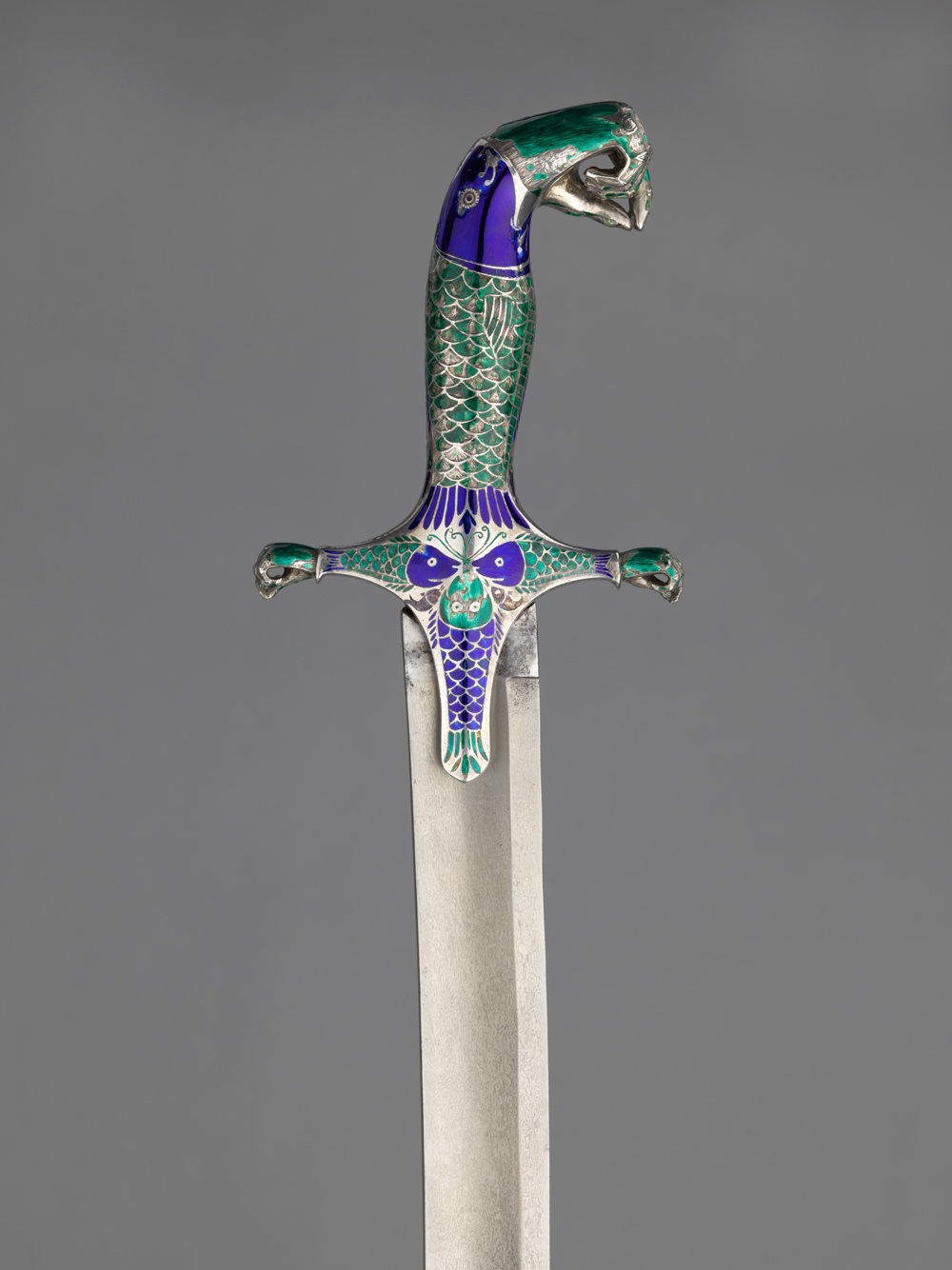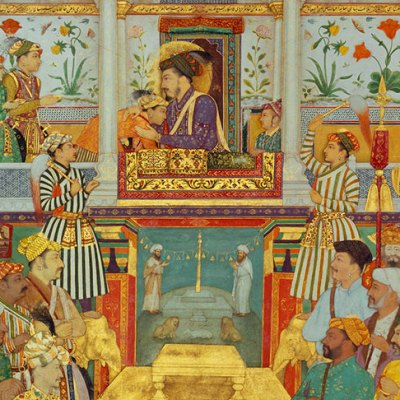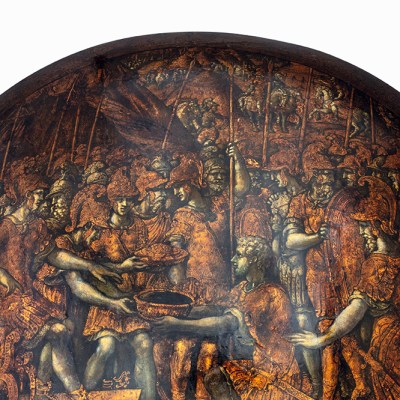From the November 2025 issue of Apollo. Preview and subscribe here.
When the writer Edward Bulwer-Lytton came up with the phrase ‘the pen is mightier than the sword’ in 1839, he had surely never seen the swords crafted in Lucknow at the turn of the 19th century. Not only were these some of the most magnificent weapons being produced at this time, but their making also arose out of a violent history – one that rewrote the rules of power in the Indian subcontinent. In 1738–39, Nadir Shah, the emperor of Iran, invaded northern India. He and his forces sacked Delhi, raided the Mughal treasury and carted off the Peacock Throne, a jewel-studded 17th-century marvel that had taken seven years to make. Politically and symbolically this dealt a crushing blow to the Mughal Empire and, over the following decades, a number of regional courts started gaining prominence and power.
One of these was Lucknow, in the province of Awadh (also known as Oudh). By the early 19th century Lucknow was among South Asia’s pre-eminent cities: its rulers were keen that it eclipse Delhi as a cultural capital and lavished their patronage on poetry, painting and decorative arts. The art made in Awadh in the 18th and early 19th century, particularly painting, remains celebrated today; the traditional embroidery technique chikankari is also well known. Swords, however, get less time in the limelight, despite the important part they played in court culture. They were given as diplomatic gifts to courtiers and visitors to the courts, usually in khilat (robes of honour) ceremonies, in which the ruler would present head-to-toe garments, often accompanied by jewellery and a sword or dagger. The ruler would wear all this before presenting it to his subordinate – the idea being that it would be invested with his essence, so that the recipient would be physically incorporated into his realm. It was an enactment of court hierarchies: the value of the sword that people were given would be commensurate with their rank. They were, literally, status symbols.
This particular sword, made sometime in the early 19th century, was not the most prestigious weapon one could have received: it was not studded with diamonds or other precious gems. But we can tell from the extraordinary enamelwork that it would have been the type to be flaunted at court. The more enamel on the sword, the more illustrious the bearer, since enamelling was time-consuming and expensive work. First, the hilt had to be fashioned. Then, using a variety of steel tools, the enameller would have made some incredibly fine incisions into the silver surface – in the case of this hilt, the incisions resemble fish scales – before applying the enamel. To make the enamel the craftsman would have crushed coloured glass using a mortar and pestle, added water to create a paste and applied this paste to the grooves. Then he would have fired it in a kiln and burnished it, giving it a lovely shine.

Nineteenth-century kilns were not like the kilns of today: you couldn’t set them to a specific temperature. The craftsman would have had to monitor it by instinct and intuition, controlling the heat with a blowpipe: if left in the kiln for too long, the colours would bleed, as each colour has a different melting point. The enameller needed a mastery of melting points, control over the fire and good taste to pair the colours nicely – this sword features blue and green, two colours associated with Lucknow.
The blade, too, is remarkable. Affixed to the hilt using lac, a sticky resin secreted by lac insects, the blade tapers elegantly across its width. This is a lethal weapon: some scholars maintain that such swords were purely ceremonial, but they very well could have been used. There were assassination attempts at some Indian courts; it was a militaristic society and these were turbulent times. Having such a sword attached to the waist would have signalled not just the wearer’s status but also his readiness for combat.
The blade is made of high-carbon watered steel, commonly known as Damascus steel. Europeans tried to replicate the beautiful marbled patterns but couldn’t do it without pattern welding – mixing different kinds of metal. That’s not how the patterns on this sword were achieved: the craftsman heated the steel with certain plant materials so that the steel absorbed some carbon. This was to strengthen the steel rather than for aesthetic purposes, but after the heating process, polishing it with a weak acid – from a lime or a pomegranate, say – would have brought out these patterns to dazzling effect.
We’re fortunate that the marbled effect is still visible on this sword, even if it’s too faint to show up in the photographs. Many swords were vigorously polished by dealers in the 19th century, which rubbed the Damascus finish right off. Conservators can revive the patterns simply by applying fruit acid, but this isn’t a decision to be taken lightly: one could argue that excessive polishing is part of the history of the object, and conservators generally try to interfere with the object as little as possible – even when the item in question has been transformed by its previous owners.

Blades and hilts were swapped around throughout South Asia to keep pace with changing fashions, and this sword is no exception. Look at the ricasso, the unsharpened part where the blade joins the hilt: it’s a little wide, and seems like it was filed down slightly to make it fit. Ricassos, which provide a safe spot for the wielder to rest their index finger, are common in European swords. That this particular sword has a ricasso suggests that the blade was also made in Lucknow, which in the early 19th century was a melting pot of cultural influences. As well as the rulers, who were of Iranian heritage, and the many artists who had arrived from Mughal Delhi as the empire collapsed, there were an unusually high number of Europeans at the court, from painters to mercenaries.
The sword may be a compound creation, but the scabbard is an original one. This is not always the case. Swords were worn as a normal part of courtly dress: if you were presented a sword by a ruler, you’d be expected to wear it, not hide it in your house. This naturally led to wear and tear, and many scabbards have been fitted with new fabric over the centuries. They can also suffer from the warping of their wooden cores over time, which can make it a little tricky to unsheathe and resheathe the sword.
This particular scabbard, made from locally sourced wood covered by early 19th-century European velvet, is a marvellous specimen. We don’t know where in Europe the velvet would have come from, but it likely made its way to India via established trade networks. One of the British expats in Lucknow’s orbit was Robert Home, who designed a multitude of objects for the court. Designs by Home and other artists would have fed into swords like this one.
The animal imagery that appears on many of the hilts was often intended to show dominance but sometimes simply referred to courtly leisure activities. There were a lot of ram fights at the court, for instance, which helps explain the rams on some of the hilts. On this particular sword, fish take pride of place. In 1720, the Mughal Emperor bestowed upon Saadat Khan, the first Nawab of Lucknow, the right to adopt the exalted ensign mahi-ye maratib, or the ‘Fish of Dignity’, which would have been held aloft as a standard in military or ceremonial processions. The symbol would have resonated with both Hindus and Muslims: in Islamic cosmology, the world is indirectly borne on the back of a fish; in Hindu mythology, a fish is the first of the 10 avatars of Vishnu.

Over time, the fish became the primary emblem of the court of Lucknow – even today, a pair of fish are a prominent part of the state emblem of Uttar Pradesh, where Lucknow is now situated. It cropped up in architecture, furniture and even fish-shaped boats (of which none, unfortunately, are extant). Fish are all over this sword: as well as the scale-like incisions on the hilt there are blue and green fish on the crossguard, plump fish-shaped scabbard fittings and, most memorably, the tip of the scabbard – chape is the technical term – which makes it look like a fish is energetically swimming up the sheath. The chape was crafted in a similar way to the hilt, with enamel on silver. It’s affixed to the scabbard with some kind of plant or animal-based glue. The attention to detail is wondrous: look at the fish’s pupils, with their minute application of pink enamel.
Many of the hilts from this period are animal-headed, so the hand motif on the pommel and at the ends of the crossguard here is unusual. We aren’t aware of any particular symbolism for the hand gesture. Some swords from Lucknow have a string of glass beads several centimetres long coming down from the mouth of the animal-shaped pommel and connecting to the crossguard. There are portraits that show this bead-string detail as well – a bit like a decorative knuckle-guard, with no protective function. So perhaps the fingers at the bottom of this hilt were pinching a string of beads. In any case, it’s a pleasingly quirky detail.
Most of the historical sources we have tend to concern the elites, so we know little about the lives of the craftsmen – and it would have been men – who created this sword and scabbard. This is despite the fact that a large proportion of Lucknow’s working population were professional artisans. Some would have been attached to the court, some not. What we do know is that the craftsmen, who learned the craft from their fathers, would have enjoyed generous patronage at Lucknow. Given how much of the population comprised artisans, patronage was part of a ruler’s duty. By spending extravagantly on decorative arts and craftsmanship he was essentially keeping the labour market afloat. We don’t know for sure whether this sword was given as a gift or purchased by commission, but either way it’s a rarefied example of the fine art of weaponry.

As told to Arjun Sajip.
Nicole Ioffredi is curator of ‘Swords of Lucknow’, which is at the Wallace Collection, London, from 26 November–22 March 2026.
From the November 2025 issue of Apollo. Preview and subscribe here.



